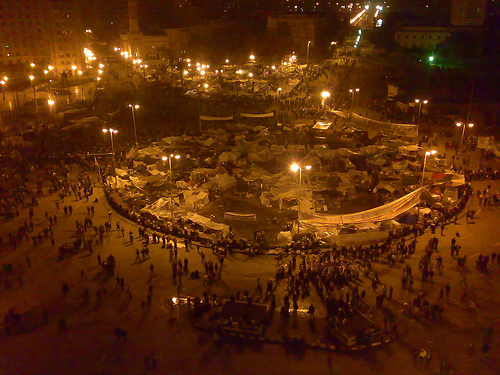
Not too long ago, I met up with a friend of mine who used to be an analyst for the State Department. One of the hot topics of our dialogue included the subject of peacebuilding efforts in Africa. During the conversation, he recounted a story about a project he was involved with where he was tasked with helping evaluate a peacebuilding project in Northern Uganda. The project involved building a peace center and culminated in hosting two peace conferences where the opposing parties were both brought to the table. The recipients of the money were very proud of their achievement, however when my friend asked them this question: “What difference have these conferences made to decrease conflict in the area,” they didn’t know the answer. This vignette highlights the difference between outputs (hosting a peace conference) and outcomes (a decrease in violence) and the particular complexities of trying to monitor and evaluate conflict.
My last post was about Ushahidi and its novel approach to monitoring conflict through the combination of SMS, Twitter and geo-mapping. At the center of the Ushahidi methodology for crisis monitoring is crowdsourcing: the use of the general public’s knowledge or opinion to provide information. Most of us benefit from crowdsourcing every day. When we shop on Amazon, we look at an item’s reviews. When we rent a movie on iTunes and Netflix, we look at its ratings. These both use crowdsourcing methods.
Contrast this use of the general public to provide information about conflict in an area with the idea of using experts in different fields to provide us with more informed opinions and observations founded in a deeper knowledge base of experience. We benefit from this approach, for instance, when we want to buy a large appliance and go to Consumer Reports, whose expert staff has information on thousands of items.
Weaknesses of a Ushahidi: Limits to Access
While there is great innovation in harnessing the general public’s information through crowdsourcing via SMS and Twitter, these methods have their drawbacks. First, Ushahidi utilizes a small army of volunteer computer programmers to implement a specific version of the map when a new crisis arises. The code is “open source” meaning that anyone can have access to it, but unless you are a programmer or know programmers, this is really of no use. Having the code open sourced also allows anyone to create their own customized version of the crisis map. In the recent uprising in Egypt, there were five different versions of crisis maps created by several different factions.
Another significant weakness to the method is that you do not know who is providing the information. Because of this, there could be disinformation sent. Ushahidi attempts to guard against this through validating both users and content. Perhaps Ushahidi’s greatest weakness is its dependence upon the general public’s access to cell phones and internet. Countries in Africa with the highest cell phone penetration include South Africa (85%), Egypt (70%), and Kenya (50%). The people who live in poverty typically are most susceptible to violent acts and marginalization and can rarely afford a cell phone.
An alternative to Ushahidi: Experts and SMS
A less expensive, lower-tech alternative to Ushahidi is using experts to relay information using SMS texting. This is what my company did in the 2010 Burundi presidential election to monitor the post-election violence. In Burundi, primary schools function as community centers where information is exchanged and where networking occurs. Because of this, primary school teachers were used as “experts” and were sent questions through SMS, asking about any election-related violence they saw or heard about from credible sources in their networks. The results of this surveillance indicated a low level of violence related to the election, which was validated through various media reports coming out of the country. This approach avoided many of the weaknesses of Ushahidi, especially given Burundi’s low cell phone penetration rate of only 10%.
Despite the challenges of monitoring and evaluating peacebuilding efforts, practitioners in the field have increasing access to a variety of tools that can strengthen the capacity to better evaluate their work and leverage their impact. As these monitoring and evaluation tools begin to be used more effectively, stories like the one in Uganda will hopefully occur less frequently.
 [Mara J. Roberts (MA, ’11) is the Director of Conflict Recovery at New Dominion Philanthropy Metrics. This is the second post in two-part series on the use of technology in monitoring conflict (see part one). Acknowledgements: David Roberts, who oversaw the technical details of the 2010 Burundi election violence surveillance, contributed to this article.]
[Mara J. Roberts (MA, ’11) is the Director of Conflict Recovery at New Dominion Philanthropy Metrics. This is the second post in two-part series on the use of technology in monitoring conflict (see part one). Acknowledgements: David Roberts, who oversaw the technical details of the 2010 Burundi election violence surveillance, contributed to this article.]

This is a great post, Mara; thanks for submitting it. The only thing I’d like to point out is about one of your links, the one talking about the five versions of the conflict/revolution situation going on in Egypt earlier this year (http://owni.eu/2010/12/08/quick-stop-all-ushahidi-deployments-in-egypt/). Actually, now that I look at the date of that post, it was posted before the revolution…so I wonder if the 5 instances were still going when the revolution broke out? Anyway, back to my original point…
First of all, the tone of the entire post is one of sarcasm. So all the things the author is saying are “bad” are actually “good” (this becomes somewhat more obvious as you continue through the piece). I’m not assuming you missed the sarcasm, but it might be easy for others to miss it if they don’t read carefully.
So actually, the good thing about five versions of a Ushahidi-based conflict map is that you get some dimension of corroboration. And as the author points out, this will become increasingly helpful as various instances of Ushahidi maps around a particular conflict will eventually be able to “talk to each other” behind the scenes, building an automated distributed network view of a conflict.
Now, the weaknesses you rightly identify in your post are still at play in a situation like this. Limits to access and quality of crowdsourced information will continue to be potential pitfalls, even in a distributed network of Ushahidi maps.
Hi Brian,
Thank you for your comment. You bring up a good point: if the five conflict maps had their data linked, this could create a stronger understanding of the conflict. But I do not think this occurred in Egypt.
Very interesting piece. Thank you for your perspective. I agree that multiple Ushahidi maps could be good or could be bad depending on how they are used. If the various maps “corroborate” as Brian mentions, it seems like having just one, centralized map would be the easiest and follow the wisdom of KISS (keep it simple stupid).
I can see that, especially in the case of monitoring election violence in places like Burundi, that using SMS with experts who have cell phones would be the way to go. But would you recommend this method over the Ushahidi method in more developed locations like Egypt?
Alan,
Thank you for your thoughtful comments. I agree that one map in the case of Egypt, would have been the simplest route. I can also see how the Ushahidi staff would be excited about multiple conflict assessments maps for the Egypt election in 2010 and violence in 2011. In general, I do see this as a potential weakness.
As to your question, Egypt’s urban areas are ideally suited for Ushahidi. So it would be hard to not use it in this location. But, my recommendation for monitoring election violence would be to implement both an Ushahidi-style conflict map AND an SMS surveillance utilizing experts. A tool using both methods would capture the benefits of both monitoring systems.
Mara, thanks so much. This is interesting. I have just been introduced to USHAHIDI and I just started using it for my work. It is a good tool for mapping (not necessarily monitoring) crisis.
We are using it here for elections violence reporting and for displaying early warning alerts from around the country. I have not really taken the time to look at the weaknesses as mentioned in your article until now. What I can say is that despite these, I am still finding the system useful. To do an in-depth analysis of conflicting situation especially when looking at trends and patterns, the use of a variety of tools is needed. For me, USHAHIDI has the potential of being one of those tools that can be very useful when analyzing; and for my early warning work, I can have alerts from USHHAHIDI in real time that I can in turn use to alert response actors cloth with the authority to take necessary action.
Working in Liberia as an early warning consultant, I coordinate a network of organizations using the USHAHIDI platform. One major potential weakness in the system we noticed from the very beginning had to do with credibility of information appearing on the map. We felt that to ensure credibility of all of the information appearing, we had to ensure that there was inaccuracy in all of the reports. We therefore set up from within the group a verification task force. The taskforce set criteria for verifying information that appears on the map. It meets regularly to approve and or verify reports. If anyone is interested in this process, I will be happy to say more when contacted. In any case, thanks Mara for making me to reflect on the usefulness of USHAHIDI to my work.